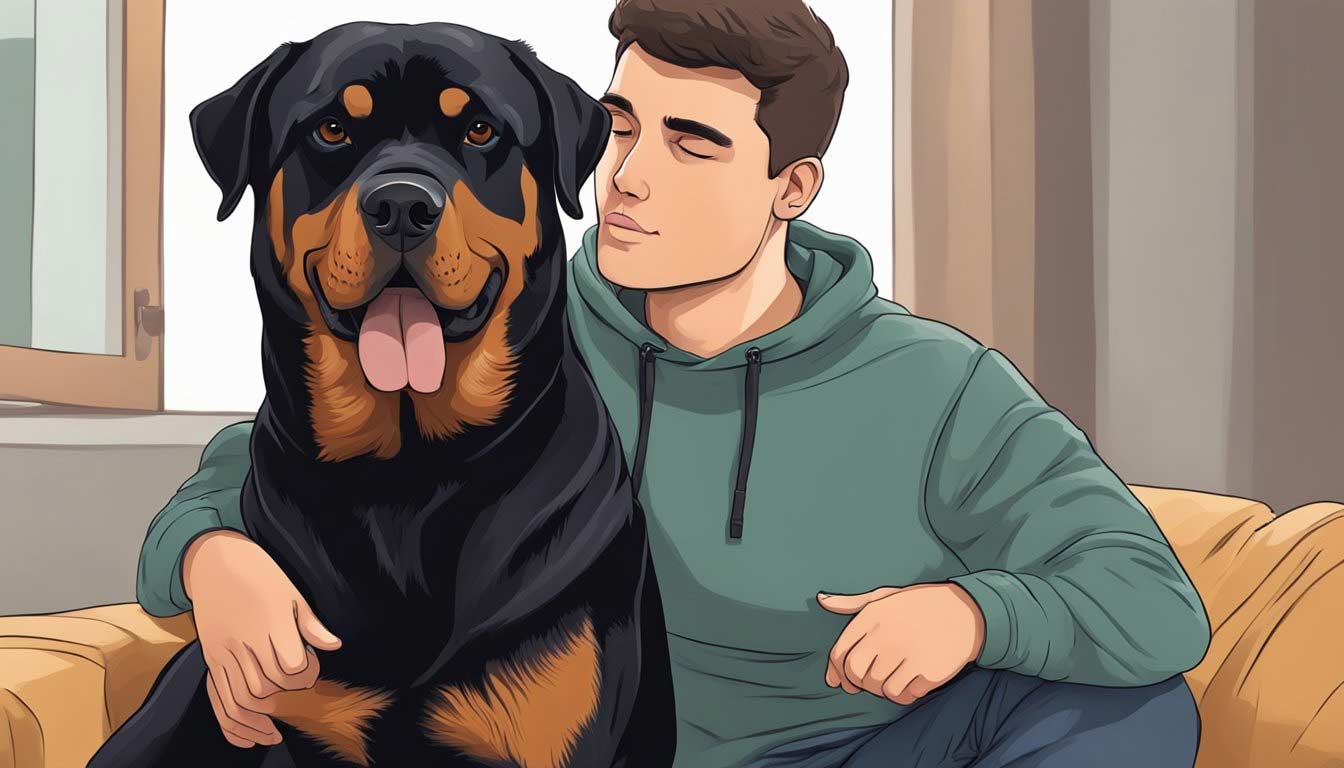Rottweilers are known for their loyalty, protectiveness, and herding instincts. They are an affectionate breed that often seeks attention and comfort from their owners.
However, some Rottweilers may exhibit behaviors that can be puzzling to their owners, such as sitting on them. Understanding Rottweiler behavior can help owners understand why their furry friend may exhibit certain behaviors.
Breed Characteristics
Rottweilers are a breed that was initially developed to herd livestock and pull carts. They are intelligent, strong-willed, and instinctively guard and protect their family.
Due to their herding instincts, Rottweilers may display certain behaviors, such as nipping at heels or trying to herd their family members. Additionally, Rottweilers are known for being a bit clingy and may seek attention and comfort from their owners.
Signs of Affection
Rottweilers are an affectionate breed and have a lot of different ways of showing their love for their owners. One way they may show their affection is by sitting on their owners.
This behavior is often a sign that they want to be close to their owner and feel safe and secure in their presence. Additionally, Rottweilers may lean up against their owners as another way of showing their affection.
Seeking Attention and Comfort
Rottweilers may also sit on their owners to seek attention and comfort. This behavior may be more common in Rottweilers that have not received enough attention or exercise.
By sitting on their own, they may be trying to communicate that they need more attention or playtime. Plenty of exercise, attention, and playtime can help alleviate this behavior.
Anxiety and Separation Issues
Rottweilers sometimes sit on their owners to cope with anxiety or separation issues. This behavior may be more common in Rottweilers who have not been properly socialized or have experienced traumatic events.
If your Rottweiler is exhibiting this behavior, it’s essential to address any underlying anxiety or separation issues. Plenty of exercise, socialization, and positive reinforcement training can help alleviate this behavior.
The Psychology Behind Sitting Close
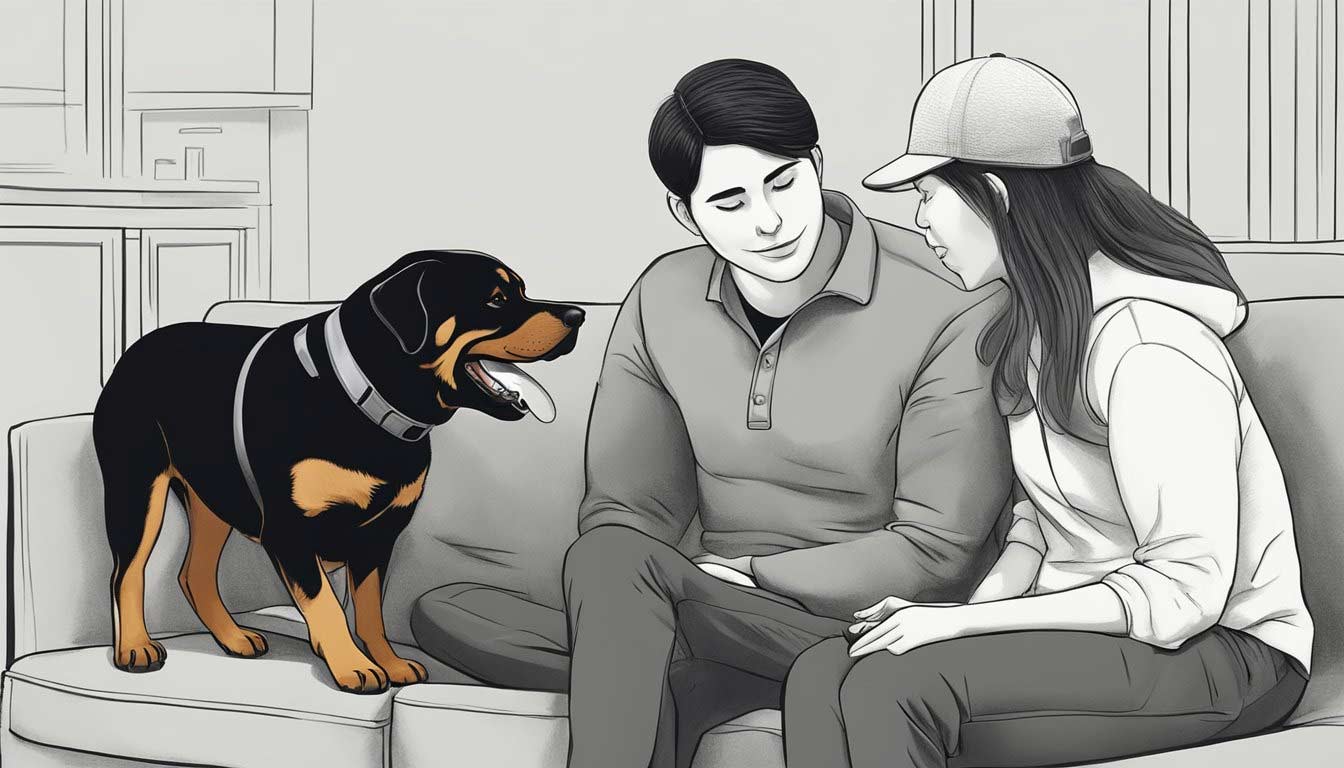
Rottweilers are known for their loyalty and affectionate nature towards their owners. One of the behaviors that Rottweilers exhibit is sitting close to their owners, which can often lead to them sitting on their owner’s lap. This behavior is influenced by different psychological factors that are natural to the breed.
Dominance and Leadership
One of the primary reasons why Rottweilers sit close to their owners is to establish dominance and leadership. Rottweilers are pack animals naturally inclined to establish their position within the pack.
Sitting close to their owners, Rottweilers indicate that they consider themselves part of the owner’s pack and recognize the owner as the leader.
Protective Instincts
Another reason why Rottweilers sit close to their owners is due to their protective instincts. As a breed, Rottweilers are known for their protective nature towards their owners and territory. By sitting close to their owners, Rottweilers can better monitor their surroundings and protect them from threats.
Territorial Behavior
Rottweilers are also known for their territorial behavior. They tend to be very possessive of their living space and their owners.
Sitting close to their owners, Rottweilers indicate that they consider their owners part of their territory. This behavior is often seen in Rottweilers who have not been appropriately socialized or have experienced separation anxiety.
Training and Behavior Modification
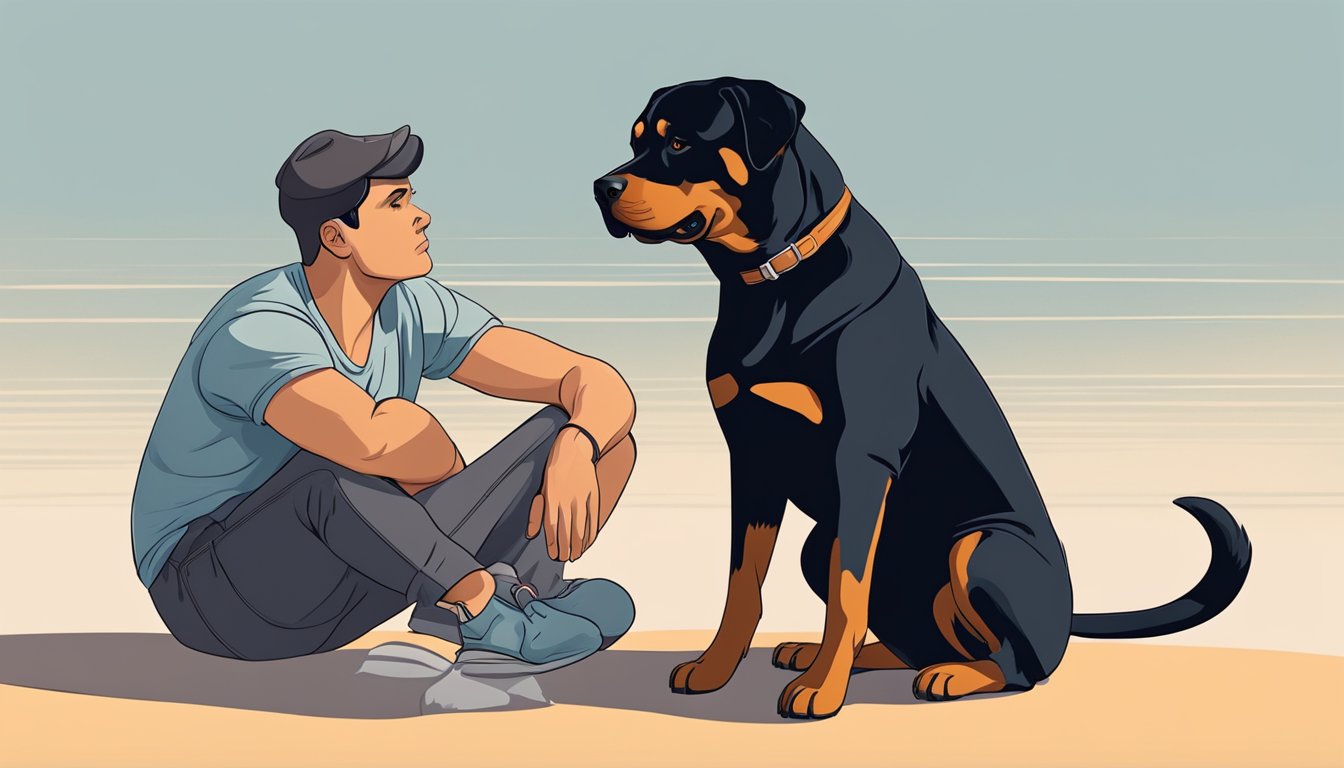
Training and behavior modification are crucial to addressing the issue of a Rottweiler sitting on their owner. Positive reinforcement techniques are great because they center around rewarding good behavior instead of punishing undesirable actions.
This approach encourages positive conduct and can be very effective. This approach helps to establish a positive relationship between the owner and their dog, promoting respect and control.
Positive Reinforcement Techniques
Positive reinforcement training involves rewarding good behavior with treats, praise, or affection. This method helps establish a positive association between the behavior and the reward, increasing your dog’s chances to repeat the behavior. This approach is particularly effective for Rottweilers as they respond well to positive reinforcement.
Establishing Routines
Establishing routines is essential for any dog, especially for Rottweilers. These dogs thrive on consistency and structure, and exercises help to develop this. By creating a routine, the dog will know what is expected of them and when to reduce confusion or anxiety.
Obedience Training Essentials
Obedience training is essential for any dog, and Rottweilers are no exception. Basic obedience commands like “sit,” “stay,” and “come” are crucial for establishing control and respect. Consistency is critical in obedience training; owners should always use the same commands and techniques.
Health and Exercise
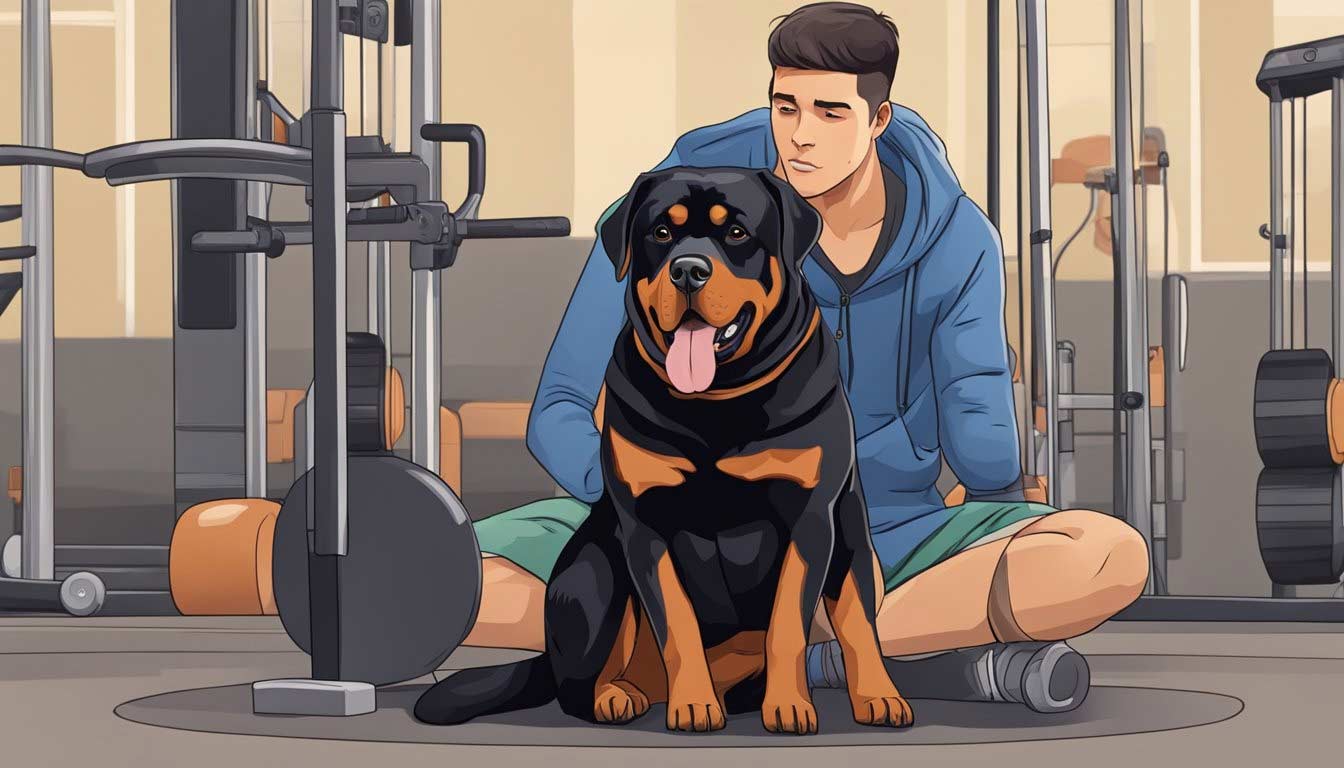
Importance of Regular Exercise
It’s essential to ensure adult Rottweilers stay healthy, and one way to do that is by giving them regular exercise. This helps keep them strong and happy, and it also lowers the chance of them having health problems.
One big reason for regular exercise is to help them stay at the right weight. Rottweilers can easily become too heavy, which can cause issues like joint pain, heart disease, and diabetes. Doing exercise often can prevent them from becoming overweight and keep them at a good weight.
Exercise is also suitable for their behavior. Rottweilers are full of energy; if they don’t exercise enough, they might start chewing and digging. Regular exercise helps them use their energy and stops them from getting bored. This way, they stay out of trouble and feel good both in their body and mind.
Identifying Health Issues
Ensuring your adult Rottweiler’s well-being involves regular exercise and staying vigilant about potential health issues. Common concerns for Rottweilers include hip dysplasia, elbow dysplasia, and osteosarcoma.
Hip and elbow dysplasia are inherited conditions impacting the joints, potentially leading to pain and arthritis if not addressed. Maintaining a regular exercise routine can play a vital role in preventing these issues promoting overall joint health and strength.
Osteosarcoma, prevalent bone cancer in Rottweilers, can be mitigated by regular exercise to maintain strong and healthy bones. It’s crucial to remain attentive to any signs of discomfort or pain in the bones, as these could be early indicators of osteosarcoma.
Socialization and Environmental Factors
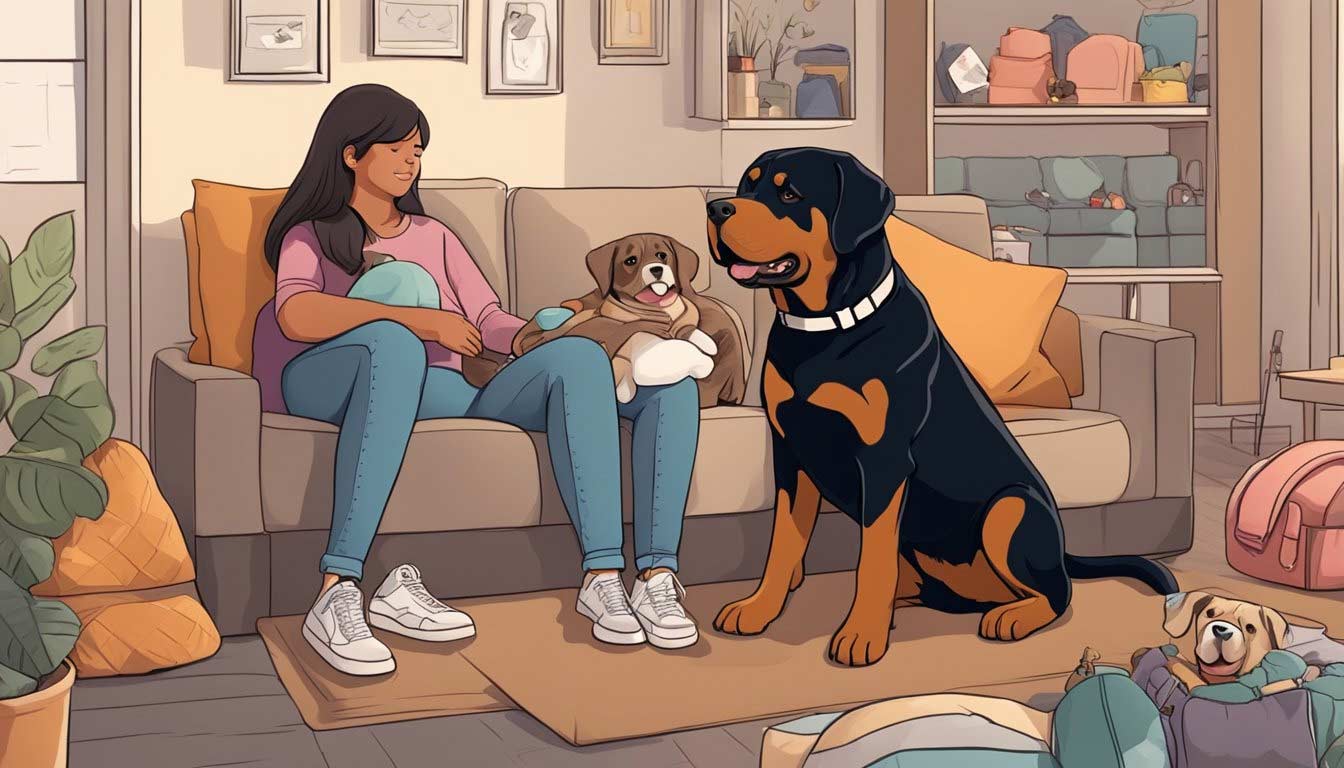
Socialization with People and Pets
One of the primary reasons why a Rottweiler may sit on their owner is due to their socialization with people and pets.
Rottweilers who have been well-socialized from a young age tend to be more confident and comfortable around people and other animals. They are more likely to seek human attention and affection, which can manifest in behaviors such as sitting alone.
On the other hand, Rottweilers who have not been adequately socialized may be more anxious and uncomfortable around people and other animals. They may not know how to interact with humans and resort to sitting with their owners to seek comfort and security.
Understanding Environmental Cues
Environmental cues can also explain why a Rottweiler may sit on their owner. For example, if a Rottweiler is used to sitting on furniture such as sofas or chairs, they may transfer this behavior to their owner’s lap.
Additionally, if a Rottweiler has been trained to sit on command, they may sit on their owner to show obedience and seek praise.
Playtime and lack of socialization can also explain why a Rottweiler may sit on their owner. Rottweilers not given enough opportunities to play and interact with other dogs may seek human attention more frequently.
Similarly, Rottweilers who have not been socialized with people may be more likely to seek their owner’s attention to feel secure and comfortable.
Interpreting Your Rottweiler’s Signals
Understanding your Rottweiler’s behavior is crucial for interpreting their signals. Rottweilers are known for their affectionate and loyal nature, but they may also exhibit dominant behavior if they feel threatened or insecure. Here are some ways to interpret your Rottweiler’s signals:
Physical Gestures and Vocalizations
Rottweilers may communicate their feelings through physical gestures and vocalizations. For example, if your Rottweiler leans on you, it may be a sign of affection or a request for attention. On the other hand, if your Rottweiler growls or shows their teeth, it may be a sign of danger or warning.
Another physical gesture that Rottweilers may use is licking. If your Rottweiler licks your face or hands, it may be a sign of affection or a way to show submission. However, if your Rottweiler licks excessively or in a specific spot, it may be a sign of discomfort or pain.
Assessing the Situation and Environment
Interpreting your Rottweiler’s signals also involves assessing the situation and environment. For example, if your Rottweiler sits on you calmly and relaxedly, it may be a sign of affection or a request for cuddling. However, if your Rottweiler sits on you tensely or aggressively, it may signify dominance or territorial behavior.
Additionally, Rottweilers may use their sense of smell to communicate. If your Rottweiler sniffs a specific spot or object, it may indicate curiosity or investigation. However, if your Rottweiler sniffs excessively or in a particular area, it may indicate danger or threat.
Enhancing the Bond with Your Rottweiler
Rottweilers are famous for their loyalty and affection towards their owners. One of the ways they show their love is by sitting on their owners. If you’re wondering why your Rottweiler sits on you, it could be a sign that they want to bond with you more closely. Here are some ways to enhance the bond with your Rottweiler:
Quality Time and Physical Contact
Rottweilers thrive on attention and physical touch. Spending quality time with your Rottweiler, such as walking or playing fetch, can help strengthen your bond. Physical contact, such as cuddles and petting, can provide comfort and security to your furry friend.
Recognizing Individual Needs
Each Rottweiler has their unique personality and needs. Some may crave more attention and physical touch, while others prefer more playtime. Recognizing and fulfilling your Rottweiler’s needs can help build a stronger bond.
It’s important to remember that building a bond with your Rottweiler takes time and patience. By spending quality time with your dog and recognizing their needs, you can strengthen your bond and create a lifelong companionship filled with love and affection.
Addressing Problematic Sitting Behavior
While sitting on their owners can be a sign of affection, it can sometimes become problematic for Rottweilers. This section provides tips on managing this behavior and when to consult a behaviorist.
When to Consult a Behaviorist
If your Rottweiler’s sitting behavior becomes problematic, it may be time to consult a behaviorist. A behaviorist can help identify the root cause of the behavior and provide a personalized training plan to address it. Some signs that it may be time to consult a behaviorist include:
- Aggressive tendencies: If your Rottweiler becomes possessive or aggressive when sitting on you, it might indicate an underlying concern that requires professional attention.
- Unresponsive to training: If your Rottweiler continues to sit on you despite your efforts to train them out of it, a behaviorist can offer extra help to change this behavior.
- Biting or fighting: If your Rottweiler becomes aggressive or bites when sitting on you, it’s crucial to get professional assistance immediately to prevent harm.
Managing Possessive and Aggressive Tendencies
If your Rottweiler displays possessive or aggressive tendencies when sitting on you, it is essential to address the behavior immediately. Here are some tips on how to manage this behavior:
- Assert dominance: If your Rottweiler is sitting on you as a way to assert dominance, it is essential to establish yourself as the pack leader. This can be done through consistent training and setting clear boundaries.
- Provide a designated sitting area: Offer your Rottweiler a comfortable and designated place to sit, such as a bed or mat. This can help redirect their behavior and provide a clear boundary.
- Use positive reinforcement: Reward your Rottweiler for sitting in their designated area, not on you. This can help encourage the desired behavior and discourage the problematic behavior.
- Seek professional help: If your Rottweiler’s possessive or aggressive tendencies persist, it may be time to consult a behaviorist for additional guidance and support.
